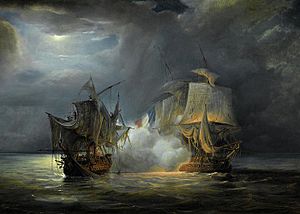Jacques Félix Emmanuel Hamelin facts for kids
Quick facts for kids
Jacques Félix Emmanuel Hamelin
|
|
|---|---|

1837 lithograph
|
|
| Born | 13 October 1768 Honfleur |
| Died | 23 April 1839 (aged 70) Paris |
| Allegiance | |
| Service/ |
French Navy |
| Years of service | 1792 - 1833 |
| Rank | Rear Admiral |
| Battles/wars | |
| Awards | Legion of Honour Baron of the Empire |
Baron Jacques Félix Emmanuel Hamelin (born October 13, 1768 – died April 23, 1839) was a brave rear admiral in the French navy. He was also given the title of a Baron. Hamelin led many naval missions and battles against the Royal Navy of Britain. He also went on important trips to explore parts of the Indian Ocean and the South Seas.
Contents
Jacques Hamelin was born in Honfleur, a town in France. When he was 17, he started learning to sail on a trade ship. This ship belonged to his uncle. In 1786, he worked on a merchant ship called Asie. It sailed to the coast of Angola. Later, he worked as a helmsman on another ship.
In 1792, Hamelin joined the French Navy. This was during the French Revolutionary Wars. He became a quartermaster on the ship Entreprenant. This ship was part of a naval group. They took part in battles near Oneglia and Nice.
In 1793, Hamelin became a midshipman on the frigate Proserpine. With this ship, he captured a Dutch frigate. He was promoted to lieutenant in 1795. On the ship Minerve, he helped capture the British ship Berwick. He also took part in a battle where 30 British merchant ships were captured. In 1796, he became a commander. He then joined a French mission to help the Irish Rebellion of 1798.
Exploring the South Seas
From 1800 to 1803, Hamelin was the captain of the ship Naturaliste. He sailed with Captain Nicolas Baudin on the ship Géographe. They went on a scientific trip to explore the southern coast of Australia. Their goal was to map the unknown coastline. They were not told to claim land for France.
This trip brought back many new plants, animals, and seeds to Europe. These came from Australia and Timor. Hamelin's crew found a special metal plate. It was left by Willem de Vlamingh in 1697. This plate had replaced an even older one from Dirk Hartog in 1616. Hamelin made sure the plate was put back. Later, in 1818, Louis de Freycinet visited it. De Freycinet had been on Hamelin's crew. When Hamelin returned to France, he was promoted to captain.
Battles near Mauritius
In 1806, Hamelin took command of the frigate Vénus. He sailed to Isle de France, which is now Mauritius. He captured four ships on his way. In 1809, Vénus arrived at Port Napoléon. This marked the start of the Mauritius campaign of 1809–1811. This was a fight between France and Britain for control of these important islands.
Hamelin sailed off with Vénus and other ships. He visited Madagascar and then sailed to the Bay of Bengal. He captured many British merchant ships. On November 18, 1809, he captured the British colony of Tappanouti. On his way back to Mauritius, he captured three large British trading ships. He captured more British ships after that. However, on September 17-18, 1810, he met HMS Ceylon. Ceylon was captured by Hamelin. But the next day, a British group of frigates captured both Ceylon and Vénus.
A Hero's Welcome
When Hamelin returned to France in 1811, he met Napoleon I. Napoleon was the Emperor of the French. Hamelin was given a high honor called the Légion d'honneur. He was also made a Baron of Empire. He became a rear-admiral and led a division of ships.
Later, he worked as a general major for the navy in Toulon. In 1823, he received an even higher honor, the Grand Officer de la Légion d'Honneur. In 1832, he became the Inspector General of Marine Crews. In 1833, he was named Director of Marine Cartography. He retired soon after and passed away in Paris. His nephew, Ferdinand-Alphonse Hamelin, also became an admiral.
Legacy and Recognition

Jacques Hamelin received a hero's welcome in 1811. His name was carved on the Arc de Triomphe in Paris. This famous monument honors important French figures. He was the only naval officer from the Napoleonic Wars to receive this honor.
He was also second-in-command during the Battle of Grand Port. This was a naval battle won by the French near Mauritius. It is the only French naval battle to be carved on the Arc de Triomphe.
See also
- European and American voyages of scientific exploration
- Cape Leeuwin
- Cape Naturaliste
- Geographe Bay
- Hamelin Bay


